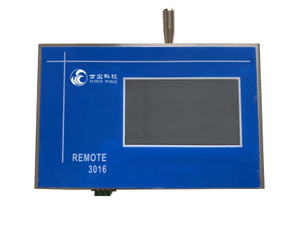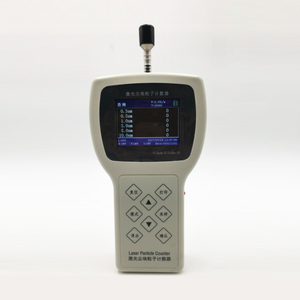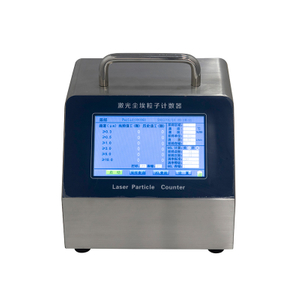Products or processes in industries such as aerospace, microelectronics, pharmaceuticals, medical devices, health care and food need to be produced or carried out in clean rooms. ISO 14644 Cleanrooms and associated controlled environments-Part 1: Classification of air cleanliness specifies that the main test is for particles of 0.1~5μm, and the clean room is divided into ISO Class 1 to ISO Class 9 according to the number of different size of particles.

As one of the key devices in cleanroom detection equipment, particle counter is very important for daily testing of cleanliness level of cleanroom.
1.What is the particle counter?
First, we need to understand what a particle counter is. A particle counter is a device designed to measure the concentration of particulate matter in the air. By sampling the particulate matter in the air and counting it with the optical sensor in the device, the number and size distribution of the particulate matter in the sample can be derived. It can be used to detect airborne microorganisms, dust, bacteria and other particulate matter contamination.
2.How does a particle counter work?
Particle counters work on the principle of optics, i.e. counting and classifying particles in the air by means of optical sensors. When particles in the air pass through the sensor, the light that is scattered is sensed by the sensor, which results in the number and size distribution of the particles. Different particle counters use different sensors and detection principles, but the core idea is to use the optical principle to detect and analyze particulate matter.
3. What are the important parameters of a particle counter?
3.1 Particle size channel
The particle size channel is one of the most basic parameters of a particle counter. It refers to the particle size range of particles that can be detected by the particle counter. In general, the particle size channels are divided into several equal intervals, each representing a different particle size range. The number and range of particle size channels will directly affect the accuracy and precision of particle counting.
Currently, there are 4 channels, 6 channels, 8 channels, 12 channels, etc. on the market. The particle size generally starts from 0.1μm and goes up to 10μm, and the required particle size channel needs to be selected according to the clean room level, and then the appropriate particle counter is chosen.
3.2 Sampling flow rate
The sampling flow rate refers to the flow rate of the sample as it enters the particle counter. Foreign use is cubic feet, converted into domestic liters, 1 cubic feet = 28.3168 liters. Dust particle counters are originally produced according to foreign standards, 0.1 cubic feet/liter is 2.83L/min. Therefore, it is generally recommended to use particle counters with a flow rate of 28.3L/min or above. Now the flow rate of dust particle counters that can be seen on the market are 0.1cfm (2.83L/min), 1cfm (28.3L/min), and 50L/min, 100L/min, the larger the flow rate, the more air data collected per minute, and the more representative of the true cleanliness level of the clean room.
At present, the pharmaceutical industry needs to detect dust particles in 1 cubic meter of air during mobile testing because of GMP regulations, so the use of 2.83L/min laser dust particle counter is obviously not suitable (need to continuously detect 350 minutes), at least 28.3L/min laser dust particle counter (continuous detection of 35 minutes), the conditional choice of 50L/min (continuous detection 20 minutes) and 100L/min (10 minutes) laser dust particle counters. If it is only used for daily online monitoring, the sampling volume and frequency can be adjusted according to the requirements of the sterile appendix, and 2.83L and 28.3L dust particle counters are recommended.
Dual sampling flow rate counters are also available on the market.
3.3 Maximum Sampling Concentration
Another important parameter is the maximum sampling concentration. This parameter is the maximum concentration of particles that can be detected by the particle counter and is usually expressed in units of units/ml. When testing samples with high concentrations, care must be taken to ensure that the particle counter is able to meet the requirements. This is because if the maximum concentration is exceeded, inaccurate results or damage to the particle counter may occur.
3.4 Self-cleaning time
Self-cleaning time refers to how long it takes for the particle counter to be cleared of contaminated particles from a previous test after the test has been performed. Therefore, it is necessary to wait for sufficient self-cleaning time before conducting the test to ensure the accuracy of the test results.
4. Work method of particle counter
4.1 Handheld
Handheld particle counter, small size, easy to carry, external Bluetooth printer, etc., is a kind of particle counter suitable for carrying around.
4.2 Fixed position
The fixed position of particle counter is usually located in the flow path of the object to be measured, such as the air outlet of the air purifier, the entrance and exit of the clean room, etc. By setting the fixed position, the particle counter can monitor the density and distribution information of the particles in the object to be measured in real time.
4.3 Online detection
Online detection means that the particle counter can transmit the information of particles in the object to be measured to the control center in real time, so that the control center can know the density and distribution of particles in the object to be measured in time. The function of online detection makes the particle counter widely used in some fields that need real-time monitoring, such as medical and health care, environmental protection and other fields.
In conclusion, particle counters are an important part of cleanroom testing equipment and have an important role to play. In practical application, it is necessary to choose the counter with appropriate parameters and working methods according to the specific application requirements to ensure the cleanliness of the clean room and the quality of the production process.













